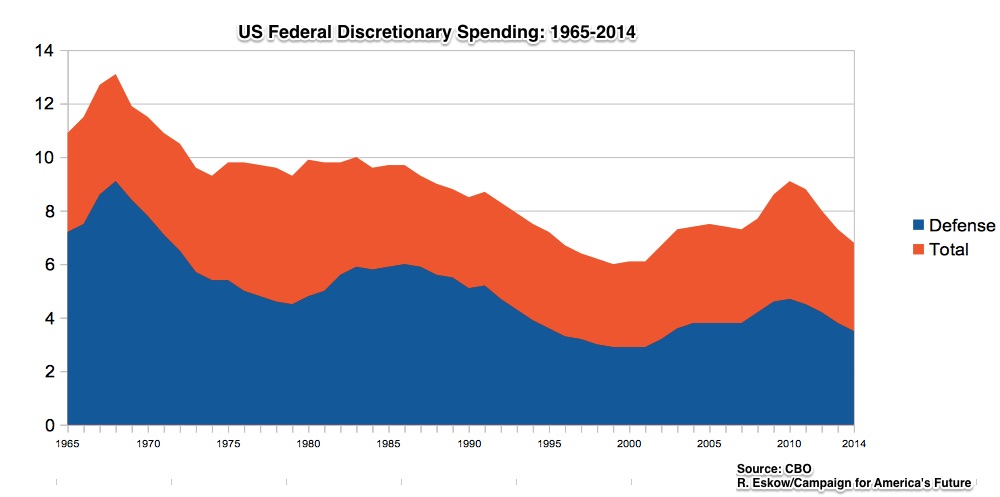This post first appeared at Campaign for America’s Future.
Has the American left lost sight of the big picture? While liberals have been fighting line-item battles against the Republican right, government itself has been changing – and slowly disappearing.
Are we winning some battles (not so many, come to think of it) but losing the war?
Discretionary spending has fallen dramatically – too dramatically – in recent decades, primarily as the result of lower, post-Cold War military budgets. But the promised post-Cold War “peace dividend” has failed to materialize. We’ve seen neither better public services nor wider prosperity. The military budget is still bloated, and only the wealthy and corporations are better off than they were four or five decades ago.
We need an active, independent left willing to challenge the push for smaller government. A well-managed government can revitalize the economy, even as it makes our world a better place to live. Many Americans seem to understand that instinctively. Where, then, is the movement that will make that argument?
Our nation needs a new vision – one that proposes using government resources to meet newer and broader challenges, instead of downsizing them to ease the tax burdens of the wealthy and corporations.
Disappearing Government
A recent report from the Congressional Budget Office (CBO) shows that discretionary Federal spending was 13.1 percent of the economy (gross domestic product, or GDP) in 1968, and was consistently above 10 percent between 1965 and 1972. Yet today it is 6.8 percent of GDP, little more than half its 50-year high.
This chart illustrates the decline in discretionary spending as a percentage of the economy:

It also shows that the reduction is largely attributable to lower military spending, which fell from a high of 9.1 percent of GDP in 1968 (that included Vietnam’s costs, as well as the Cold War’s) to 3.5 percent in 2014.
We could have invested this “peace savings” in more productive government activities. Instead, government itself was downsized – with very little debate.
The Home Front
Non-defense spending has declined too. It’s currently 3.4 percent of GDP. That’s down from its 1965 level of 3.8 percent, and is dramatically lower than its 1980 level of 5.0 percent. Those figures are even more striking when we consider the fact that some forms of military spending are included in the “non-defense” portion of the budget.
The Department of Homeland Security, for example, is considered a “non-defense” expenditure. That’s a military-related “domestic” expense which didn’t even exist in the 20th century. The president has requested approximately $48 billion for the Homeland Security in his new budget, an increase of 9.1 percent.
The proposed $165 billion budget for Veterans’ Affairs isn’t allocated to the Department of Defense, either. Additional defense-related expenditures can be found in other departments, including Energy and Justice.
Strip away all of these miscategorized expenditures and we’re likely to find that our government’s non-military spending – which according to these figures is near its 50-year low – is even lower than the numbers would have us believe.
Following the Money
Where did those savings go? They were, in effect, given to corporations and the wealthy as tax breaks.
The CBO’s data shows that corporate income taxes fell dramatically as spending declined. So did inheritance and gift taxes.
Here are the figures: Corporate income tax revenues were 3.6 of GDP in 1965, rising to 4.1 percent in 1967. But they fell to 1.9 percent in 2014, less than half of their 50-year high. And today inheritance taxes and gift taxes are one-fourth of what they were in 1965.
The Limits of the Debate
Instead of benefiting the privileged, some of those savings could have been used to fund domestic programs to improve the lives of millions of Americans.
That would have had another benefit: Studies have shown that non-military government spending is more cost-effective in creating jobs than military spending. So a shift from military to domestic spending would tend to boost both employment and middle-class wage growth, two areas where our economic picture has declined since the early decades shown in the chart above.
That’s a compelling big-picture argument. Unfortunately, nobody seems to be making it.
President Obama’s latest budget proposal shows the limit of our current debate. He has proposed increasing military and non-military (discretionary) spending by roughly the same amounts, which means that defense spending under the president’s plan would still exceed domestic spending ($561 billion vs. $530 billion – and that smaller domestic figure includes significant military expenditures, as explained above).
Why should that be the liberal side of the debate? A vibrant, independent left would propose reductions in military spending – and steeper increases in domestic spending. After all, we are the sole remaining superpower. By broad consensus, our greatest national security threat is terrorism conducted by non-state actors. Why, then, are we still greenlighting costly high-tech weapon systems?
And why are we expected to spend $355 billion in the next 10 years (according to the CBO), and as much as $1 trillion over 30 years (as estimated by the Center for Nonproliferation Studies), to maintain and rebuild our nuclear arsenal? (See also the Arms Control Association.)
That makes no sense.
A Left That’s Willing to Think Big
What would a revitalized left proposed to do about the declining size of government? First, it would point out that government has an important role to play, both in our lives and in our economy. That should be a source of pride, not a cause for shame.
A revitalized left would point out that our military spending is still out of control. It would challenge our obsession with invasive spying technology – technology that enriches NSA contractors, but threatens our freedoms and distracts us from the human-intensive efforts which genuinely make us safer.
But, even as it argues for military cuts, this new strong left would point out that well-managed domestic spending is a force for good. It educates our children and preserves our health. It can rebuild our bridges, highways, and transportation systems. It can protect our planet and support research which creates the scientific breakthroughs of the future. It can develop technologies like the Internet that transform our world and our economy.
And as it’s doing all these things, it can also create millions of additional jobs while strengthening wages for the middle class.
No Apologies
What about that portion of the government’s budget that falls under mandatory spending? The left could explain why we must expand Social Security, not cut it, promoting the well-crafted proposals that would finance that expansion. Those proposals are popular with the American people, and no wonder: Now that other forms of retirement security have been eroded, Social Security is the most cost-effective vehicle we have for replacing what’s been lost.
A bold left could argue for limiting the role of profit-making corporations in medical care. That would reduce our overall health care costs while lowering the cost of Medicare, our second-largest mandatory spending program. At the same time it could propose covering everyone under a single-payer system, since Medicare is already more cost-effective than private insurance. The resulting savings would give our economy a much-needed boost, while providing Americans with better health care.
Discretionary spending has declined dramatically over the last 50 years. But it was at its highest during some of our best years of growth and middle-class prosperity. That’s neither a coincidence nor an accident.
We’ve accepted the downsizing of government without a struggle, and that needs to change. That means reclaiming the voice and spirit of a strong and vital left, without fear or apology.
The views expressed in this post are the author’s alone, and presented here to offer a variety of perspectives to our readers.


